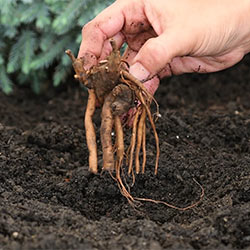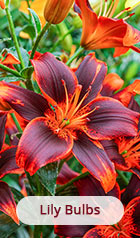
How to Plant, Grow, and Care for Tulips
Tulips are among the best-loved spring bulbs! Nothing says spring like a bright display of these classic, cupped blooms. By planting a large swath of tulips, you can attain a natural-looking, Dutch-field appearance.
What are Tulips?
Tulips are a genus of flowers grown from bulbs, and are among the most beloved and well-known bulb-grown plants. They became popular as ornamentals in Asia and Europe as early as the 11th century. Did you know that tulip bulbs were the subject of the first known pricing bubble? During the "tulip mania" of 17th century Holland, tulips were sold to collectors for outrageous prices.
Tulips grow in a wide variety of colors, sizes, and bloom times. With the right planning, you can have a full spring of tulips growing in a variety of colors, textures and heights. Most tulips are winter-hardy in zones as far north as Zone 3, and don't require lifting in much of the United States. Tulips are planted in the fall, go dormant during the cold season, and sprout in the springtime as the weather warms.
Types of Tulips
Tulips are known for their cup-shaped blooms opening on tall, stately stems. Although their shape is one of the most easily-identified silhouettes in the spring garden, tulips are far from a one-look genus! There are many types of tulips, in a rainbow of colors and a variety of bloom times. By planning ahead and purchasing a variety of tulips, you can keep your tuliip display going from early spring until later in the summer.
Tulips That Bloom in Early Spring

- Fosteriana tulips bloom at the very beginning of spring, lighting up the ground with beautiful colors and unique, pointed flowers.
- Early tulip varieties, as some varieties of single or double tulips are known, are also some of the first on the scene. Many of your classic tulips are early bloomers.
- Emperor tulips are tall early bloomers. Their large flowers have a slender, sometimes mermaid-tail shape. They naturalize well.
Tulips That Bloom in Mid Spring

- Darwin tulips have big, shapely blossoms in bright colors. These tulips tend to have nice, thick petals that curve around one another.
- Triumph tulips are known for their big flowers and long bloom times. They have sturdy stems that withstand wind and rain amazingly well. A ton of your favorite tulip varieties are likely Triumphs-they comprise a majority of store-bought American tulips, and are some of the tallest varieties. Lasting Love Tulip is a beautiful example of a Triumph.
- Species tulips are shorter and more delicate-looking than standard tulips, and look a bit like springtime crocuses. They're great for naturalizing.
Tulips That bloom in Late Spring

- Late single tulips are simply single varieties that bloom late in the season. They're often available in bright colors.
- Ruffled tulips add a bright and sassy, summer-oriented look to the garden.
- Parrot tulips are a hit for gardeners looking for something totally different in the late spring. These twisted, fringed tulips have ruffled edges and flamelike markings.
- Peony-type tulips bloom fully double, looking not unlike very early peonies. These vibrant tulips are the perfect transition into the brighter hues of summer. Our Ice Cream Tulip is a great example!
Choosing tulips to plant in your garden is a fun exercise in planning ahead-and, since tulips are planted in fall, they'll give you something to look forward to over winter!
How to Plant Tulip Bulbs
Tulip bulbs are planted in the fall, and emerge in spring, ready to bloom. The hardest part of tulip planting is waiting over winter to see them in action! So, how do you plant tulip bulbs? Here are a few easy pointers.
When Do You Plant Tulips?
Plant your tulips in the fall, after the weather has cooled but before the ground freezes. A good rule of thumb is to plant bulbs when the average nighttime temperatures dip below the mid-40s. We'll make it easy by shipping your bulbs at the right time for planting!
Planting in mid or late fall allows your bulbs to settle into the earth before the ground freezes, but doesn't let them sprout too early in the summer heat. Pro tip: if you need to transplant tulips or divide them after a few seasons, fall is the best time to do that, too!
Where Do You Plant Tulips?
Tulips will grow successfully in the majority of American landscapes. Keeping a few factors in mind, you'll be able to figure out just where to put them!
- Sunlight: Tulips grow best in full sun, although they may be burnt by hot heat in southern climates. In Zones 7 or higher, plant your tulips in a place where they'll receive afternoon shade.
- Soil needs: What type of soil do tulips grow in? Like many bulb-grown flowers, tulips perform best in loamy, well-draining soil. Don't plant them in a place where water pools.
- Spacing: Most tulips should be planted 4 to 5 inches apart, although some large varieties and dwarf tulips may have different spacing needs.
- Height and spread: Consider the height of your tulips when choosing where to plant them. In many traditional plantings, tall flowers-like Darwin or Triumph tulips-are placed in the back of the bed, so shorter plants can show off in front. Consider the height of your tulips as you place them among your other perennials and bulbs.
How to Plant Tulip Bulbs
Now that you've chosen the perfect location for your bulbs, you're ready to plant! This is the fun part.

- Work the soil well, using a trowel or spade to break up the earth at least six inches deep. This is a good time to add in compost or loam, too. These amendments can add nutrients to your soil and keep the soil from becoming too compact. Drainage is important!
- Dig holes for your tulip bulbs. A good rule of thumb is to plant each bulb three times as deep as the bulb is tall. For most tulips, that means planting the bulbs at about six inches deep. You can dig individual holes for your bulbs, or dig a long trench and space them in a row.
- Backfill over your bulbs, and add water to eliminate any air pockets around the bulbs. You won't need to water again until spring.
- Now your bulbs are planted! Some gardeners choose to add mulch here, and that can be beneficial in the colder zones. If you have issues with squirrels or other pests digging your bulbs, you can try adding chicken wire or another mesh material under the mulch.
Planting tulips is quick, easy, and a ton of fun. Next, you'll get to enjoy those beautiful blooms when they sprout in spring!
How to Grow Tulips
Tulips won't require care in the winter season, so just let them rest until they sprout in springtime. Once the growing season begins, here are some care items to check off your list:
Early Growing Season: Start Watering and Consider Stakes!
Your tulips will appreciate receiving an inch or two of water each week once the growing season starts. Many locations in the U.S. experience wet springs, but if you have a dry spell, go ahead and water your tulips.
Most tulips don't require staking, but some very tall, top-heavy tulips will require staking or other supports. If you plan to stake your tulips, do so early in the season to avoid damaging roots or causing a bend in the stem. Place a stake near the base of the plant, and loosely twine the tulip to the stake.
Blooming Time: Applying Fertilizer and Deadheading
A water-soluble fertilizer can benefit your tulips after they begin to bloom. Just apply once at the roots. Then, enjoy your flowers! As they begin to fade, remove spent blooms to keep the flowers clean and prevent them from forming seed pods. Don't cut your leaves back until they begin to die back-without foliage, your tulips won't be able to collect energy for next year.
End of the Tulip Season: Cutting Back and Getting Ready for Summer
After your stems and leaves turn brown, you can cut them down to the ground. Your bulbs will stay happily underground for the rest of the blooming season. If you plan to heavily irrigate your garden, you should lift and store your tulips for the remainder of the season-flooding your bulbs can lead to rot.
Fall Cleanup: Dividing, Mulching, and Winter Prep
Tulips propagate underground, making new tulip bulbs. This is great news for gardeners who want to naturalize a full field of tulips! However, if your tulips seem to be overcrowded after a few years, it may be time to divide. Fall is the right time to divide tulips. Making sure to dig deeply so bulbs aren't damaged, lift your tulip bulbs using a spade or shovel, separate out bulblets, and replant.
Before the winter, cover your bulb bed with two to three inches of mulch, to help insulate the bulbs before the cold sets in. Add an organic fertilizer as a dressing over your bulbs. Your tulip bulbs are now ready for winter.
Keep in mind that some of these rules of thumb don't apply to hot climates. If you live in a warm season and will need to lift your bulbs, do so in November or December!
Tips for Caring for Tulip Bulbs
With the right care, your tulips will come back year after year. Here are a few tips to make sure your tulips stay happy and healthy.
- Water thoroughly through the growing season and into fall, if dry. Tulips love moisture, as long as it isn't pooling around the bulb.
- If you plan to irrigate your summertime garden, don't place tulips in that location. Or, lift and store your tulips during the summer. Too much moisture can lead to rot.
- Cut flowers as soon as they fade - or before, tulips make fantastic cut flowers. However, never cut foliage unless it has turned brown.
- Deadhead the plants as flowers die off, but do not cut the leaves for at least six weeks after they stop growing.
- To relocate tulips, dig them up after leaves have turned brown. When the bulbs are dry, remove the roots and clean off dirt. Store in a dry, well-ventilated place until fall planting time.
Tulips are among the bulb-grown flowers that tend to fade after a few years. If you find that, by year four or five, you have fewer tulips, don't feel that you've failed your flowers. That just means it's time to plant some new bulbs!
How to Plant Tulip Bulbs In a Pot
Tulips are a great choice for container gardening, and are especially easy to force indoors. Whether you're creating a tabletop Easter arrangement or a large porch planter, tulips are a great choice! Let's walk through planting tulips in pots:
- Choose a container with lots of drainage, and plenty of depth. You'll want to plant your tulip bulbs about six inches deep.
- Fill the pot with potting soil, and mix in some loam or compost to "fluff up" the soil and add some nutrients.
- Plant the bulbs at about twice their own height, just as you would if planting them in the garden.
- Water your tulips in well. If the weather is still cool, place your bulbs indoors in a sunny window. Keep watering them weekly through their growing season.
Tulips can make a beautiful planter display, either alone or mixed with other bulbs. For something unique, try planting shorter bulbs at a shorter depth than the tulips, in the same planter. A mix of grape hyacinth or snowdrops in a tulip planter is truly stunning!
Pests and Diseases
Tulips can suffer from aphids and boring insects, as well as deer and rodents. Here are a few ways to keep your tulips safe:
- Check tulips for mites and thrips during the growing season, and set traps or use insecticide if you spot them.
- If you have a few flowers suddenly die, check the bulbs for holes or rot. If you find either, pull those bulbs and dispose of them away from your other plants.
- Squirrels and mice are known to dig up those tasty, juicy tulip bulbs. Netting over the soil can help secure your bulbs, or try planting them under a layer of chicken wire.
Commercially-available pest deterrent can help, too.
- Because of their thick leaves, tulips tend to attract deer. If you find deer grazing on your plants, try an animal repellent or fencing. Placing tulips near a busy building will also keep deer away.
- Keep an eye out for brown or rotted spots on leaves, and clip off any "bad" spots.
While animals tend to love tulips, they don't love human activity. With a bit of attention paid to the planting location, and checking your bulbs for pests or diseases, you can keep your garden tidy!
Our Favorite Tulips
It's hard to pick a favorite type of tulip-there are just so many! Here are a few that are perfect for beginning gardeners.

- Rembrandt Mixed Tulips grow in a beautiful assortment of brush-stroked hues. This is a great mix of colors, and blooms in mid-spring.

- Serrano Tulip is a lovely pink and white dwarf tulip that looks like two in one. Plant this one in the front of the garden, with taller tulips behind.

- Our Royal Tulip Blend is a sunny combination of yellows and purples. These tall single tulips bloom early in the springtime.

- Pink Siam is a beautiful example of a species tulip, ready to impress in a bright pink color in early spring. This is a low-lying tulip, perfect for borders.

- Looking for something totally different? Centennial Tulip is a smaller, but very bright and impactful, double tulip. It blooms in fiery shades or reds and oranges.
Tulips are easy to plant and care for, and they're an inexpensive way to make a huge impact in the springtime. Like what you see? Check out more of our tulips
here!
Have another question? Return to the Customer Service Help page or send an e-mail directly to Customer Service































